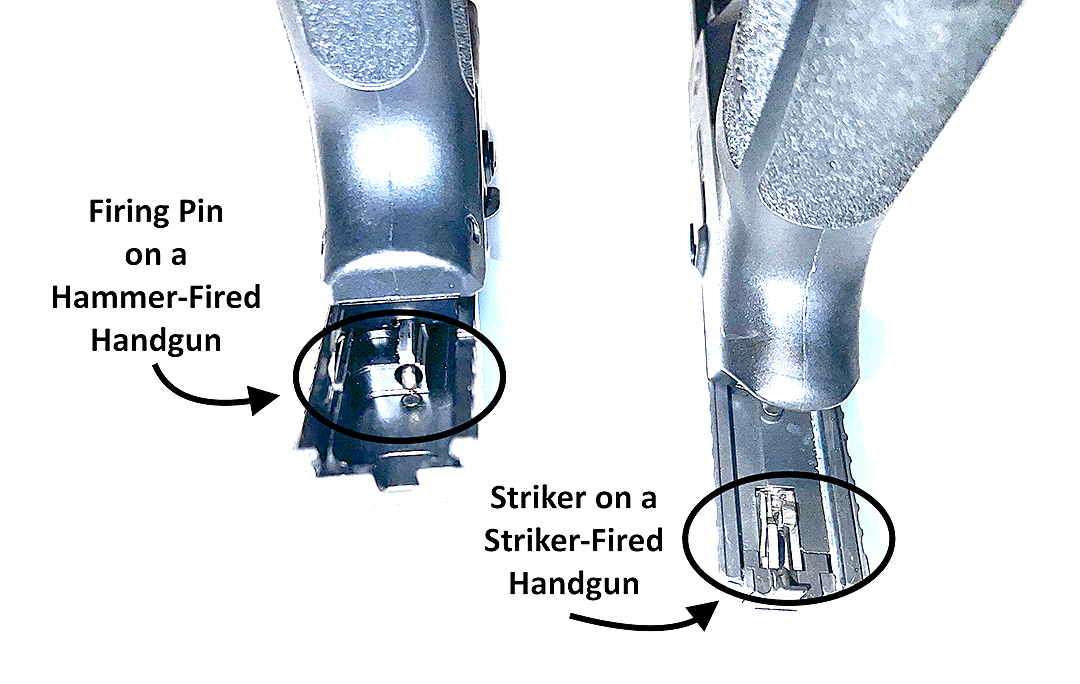Striker or hammer-fired? Which is better?

By MARJ LAW

In order to make an omelet, first you have to break some eggs. Gotta start somewhere.
The same is true of handguns. Whether you are holding a striker or a hammer-fired gun, there’s a similar issue: something has to whack the primer of the round you put in the gun. How, exactly, you do that basically boils down to whether you have a striker or a hammer-fired gun.
So how can you tell which you have? This can be confusing because you can see the hammer in hammer-fired guns. Except when you can’t. Some of the hammers are internal. You can’t see them. But that doesn’t mean they aren’t there.
You don’t see a hammer on a striker-fired gun because there isn’t one.
I’m at a gun store recently (not nearby, so don’t worry), and I want to “see” the new Ruger Security .380.
“It’s a striker-fired gun,” says the man behind the counter confidently.
Truly, I don’t see any hammer.
Just as Joe has instructed me, I lock back the slide of the Ruger. Then I turn the gun upside-down to inspect the underside of the slide.
What do you know, but there it is: a round hole with a firing pin inside. Even though I can’t see it, I know that pressing the trigger will release a hammer which will whack this firing pin.
I am holding a hammer-fired gun. Not a striker-fired gun.
What is your gun?
First, holding the muzzle in a safe direction away from you and anyone who could be hurt, release the magazine from the gun. Then pull back the slide and peer into the ejection port so that you can see the chamber. Make sure you see no round in either the port or in the chamber.
Now that you are confident your gun is unloaded, lock the slide back. Turn the gun upside-down like I did at that gun store. Do you see a hole and a firing pin within?
No? What do you see?
Directly under those rear sights of the slide you’ll see a squarish metal piece sticking up. How it works is this: when you pull the trigger, part of the trigger mechanism on the lower pulls backwards. Then it comes in contact with that striker metal piece located under the slide. It pushes the striker backwards against the force of the striker’s spring and then it releases the striker. This makes the striker fly forward. The striker is part of the firing pin, so the firing pin is flying forward too, until it hits the primer of your round.
You are holding a striker-fired handgun.
Again, in both cases you’re slamming a firing pin against your round to make the primer ignite. This explosion within the round forces the bullet forward and out of the gun. The difference between hammer and striker-fired guns is in what makes the firing pin shove into the primer.
When the Great Gun Fairy offers you either a striker or hammer-fired handgun, which will you take? Which is the better gun to own?
Joe is going to say the hammer-fired triggers are more crisp and have been so traditionally. Traditionally? Well, tradition happened a long long time ago.
Sure, hammer-fired guns were made first and that’s what you’d get for decades and decades. Striker-fired handguns have been on the market for a much shorter period of time.
And yes, the triggers were better traditionally on hammer guns. However, striker guns have more refined triggers nowadays, and I really don’t think that battle holds much ammo.
To prove his point, Joe pulls the trigger on the Sig Sauer P365 (striker) and then on the Smith & Wesson M&P .380 Shield (hammer).
“The striker trigger is a little bit sluggish compared to the hammer gun,” he reports. But he had to pull both triggers and think about it for a while. It is not an easy decision.
Joe will emphasize that once cocked, the hammer gun will have a shorter and lighter trigger pull. Yep. Back in the old days. Today, you can find many striker-fired guns with short and light pulls. Sorry, Joe. I don’t buy this one, either.
Joe will maintain that once cocked, hammer guns have slides that are easier to rack. Well, okay.
So, what is the real reason he prefers hammer guns?
“The first center-fired gun I ever shot was a hammer-fired gun. I was used to it.”
I get it. My first favorite gun was a Springfield XDM competition model. A striker. Truth is, a fine armorer called Mark worked over the gun and its trigger until the gun goes off like butter. It’s smooth and accurate, and I used to plug the x-ring with enthusiasm. Your personal history surely makes a difference in your present day likes and dislikes.
This is why I’m used to maintaining to Joe that striker-fired are best.
“What about the Smith & Wesson M&P 10mm?” I ask to make my point about strikers.
“I liked shooting that one a lot. It’s a very good gun,” he admits. “If the Great Gun Fairy offers one of those, I’d take it in a heartbeat.”
“What about your Sig Sauer 320 with all its modular variations?”
He nods. That’s a striker-fired gun too.
“And now, striker-fired handguns are less expensive than hammer-fired!” I declare triumphantly. “So, you may have to change your mind about striker-fired guns!”
“Sure,” he agrees. “Let’s talk about your striker-fired guns. How about that new little Ruger Security .380 you just bought for under $300?” he snickers, knowing my penchant for things cheap. Um, inexpensive.
“And you like the way you can rack the slide with only 2 fingers, right?” he adds, trying not to grin.
“Well,” I begin.
“You like how accurate it is, don’t you? You’re comfortable with its small grip? You like that it holds a whopping 15 rounds too, right? Oh, and finally, you’re so delighted that it’s a hammer gun!”
Drat.
Striker or hammer-fired? It just all depends…
“At the end of the day,” reports Jeremy S. on The Truth About Guns, “both hammer and striker serve the same function – to ignite a primer – and they can do it equally well. Rather than focusing on hammer vs striker, most of us would be better served by focusing on how well we shoot a given [reliable] firearm and how good of a fit it is for our hands and our carry and use preferences.”
Marj Law is the former director of Keep Wakulla County Beautiful who has become an avid shooter in retirement.
